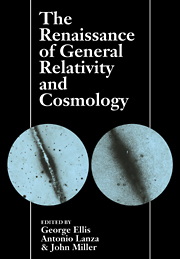 The Renaissance of General Relativity and Cosmology
The Renaissance of General Relativity and Cosmology Published online by Cambridge University Press: 15 December 2009
This is mainly a review of the properties of gravitational galaxy distribution functions. It discusses their theoretical derivation, comparison with N-body simulations, and — perhaps most importantly — their observed features. The observed distribution functions place strong constraints on any theory of galaxy clustering.
INTRODUCTION
The galaxy distribution function f(N, v) is the probability of finding N galaxies in a given size volume of space (or in a projected area of the sky) with velocities between v and v + dv. It is the direct analog of the distribution function in the kinetic theory of gases. For perfect gases, the spatial distribution is provided by a Poisson distribution at low densities and a Gaussian distribution at high densities, along with a Maxwell-Boltzmann distribution for the velocities. It is only in the last few years that we have discovered the comparable distribution for galaxies interacting gravitationally in the expanding universe. There are still many aspects of this problem which need to be understood.
Distribution functions had their origin in the observations and speculations of William Herschel two hundred years ago. In his catalog of nebulae he noticed that their distribution was irregular over the sky. Although we now know that some of these nebulae were galaxies and others resulted from stars, HII regions and planetary nebulae, and that some of the irregularities are intrinsic while others are due to local obscuration by the interstellar matter in our Milky Way, Herschel tended to view them all as a single class of objects.
To save this book to your Kindle, first ensure [email protected] is added to your Approved Personal Document E-mail List under your Personal Document Settings on the Manage Your Content and Devices page of your Amazon account. Then enter the ‘name’ part of your Kindle email address below. Find out more about saving to your Kindle.
Note you can select to save to either the @free.kindle.com or @kindle.com variations. ‘@free.kindle.com’ emails are free but can only be saved to your device when it is connected to wi-fi. ‘@kindle.com’ emails can be delivered even when you are not connected to wi-fi, but note that service fees apply.
Find out more about the Kindle Personal Document Service.
To save content items to your account, please confirm that you agree to abide by our usage policies. If this is the first time you use this feature, you will be asked to authorise Cambridge Core to connect with your account. Find out more about saving content to Dropbox.
To save content items to your account, please confirm that you agree to abide by our usage policies. If this is the first time you use this feature, you will be asked to authorise Cambridge Core to connect with your account. Find out more about saving content to Google Drive.